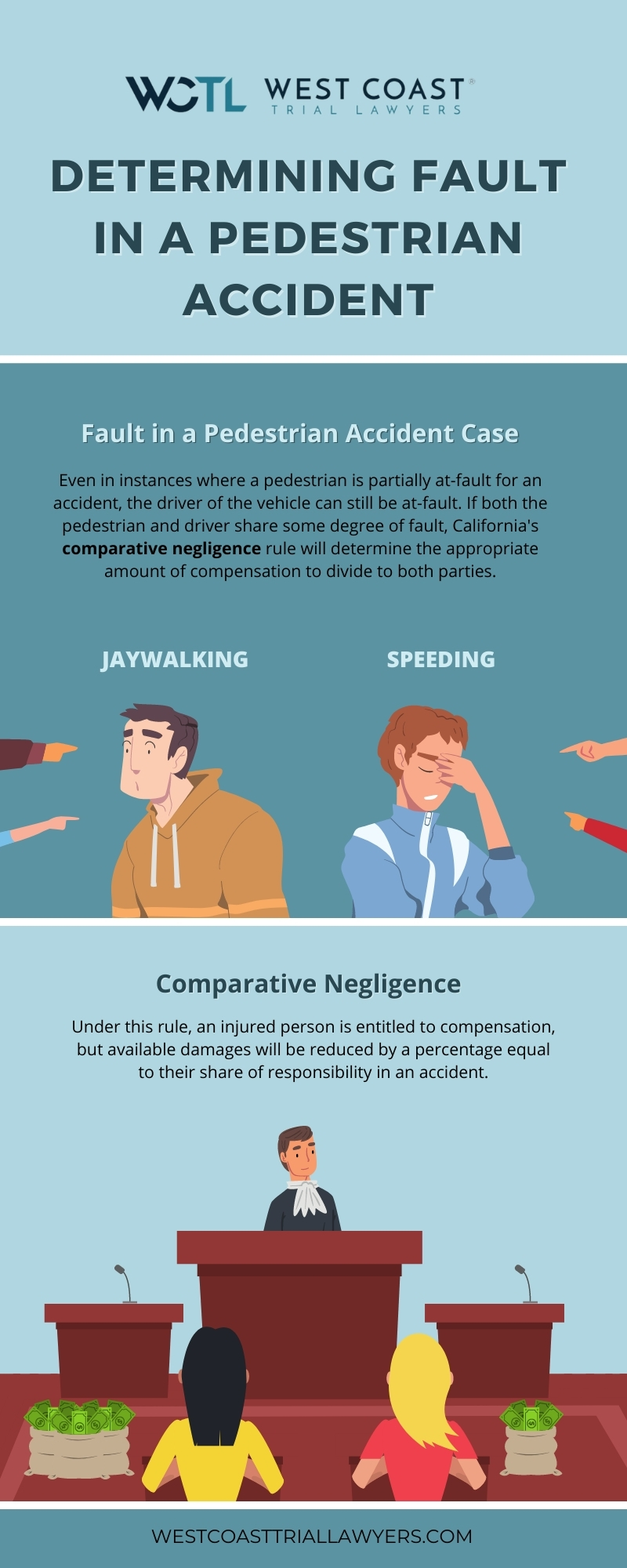
California’s Pedestrian Accident Laws
Determining Liability Under California Law: Pedestrian Protections and Comparative Negligence
According to an article written by the Los Angeles Times, California is leading the nation as the most dangerous place for pedestrians between 2013 and 2015, with at least 700 people killed annually throughout that three-year period. The most recent data from 2017 is just as alarming, as 134 pedestrians were killed. The Governor’s Highway Safety Association (GHSA) also noted that pedestrian deaths climbed by 16 percent throughout the country in 2016, which suggests the problem could be nationwide.
For California residents, these numbers are not surprising. This data only reinforces what many of us already know: California is a dangerous place for a pedestrian, especially at night. Hit and runs are a serious safety issue within the country, especially in Los Angeles. The city has reported nearly 20,000 hit and runs every year. In short, pedestrians account for about a third of all traffic fatalities, a shocking number that is almost triple the national average.
Fortunately, California offers protection for pedestrians who are wounded after a pedestrian accident. If you or a loved one was injured in a pedestrian crash in Los Angeles, you may be entitled to receive compensation. Our experienced Los Angeles pedestrian accident attorneys at West Coast Trial Lawyers will help recover all the compensation you deserve so that you can focus on your recovery and on the ones you care most about.
To schedule a free consultation at our Los Angeles personal injury law firm, please contact our 24/7 legal team by calling 213-927-3700 or filling out our quick contact form.
What Are California’s Pedestrian Laws?
Whenever the topic of pedestrian accidents comes up, people will automatically assume the driver was at-fault, which makes sense. A human being is simply no match for the oncoming rush of a heavy, metallic vehicle. However, just like the popular phrase “the customer is always right” isn’t necessarily true, neither is the phrase “the pedestrian always has the right-of-way” from a legal standpoint. When it comes to pedestrian crashes, it is possible for a pedestrian to be at-fault, either completely or partially.
Just because pedestrians are careful does not mean that they have the right-of-way, and it also does not mean they will be exempt from any liability if they are involved in a collision with a vehicle. All drivers and pedestrians have a responsibility to each other: drivers must exercise reasonable care to avoid hitting pedestrians, and pedestrians must use reasonable care to safely cross streets.
There are right-of-way laws regulating pedestrian safety. A $220 penalty will be given to any driver who fails to yield the right-of-way to a pedestrian when there are injuries involved. A $1,000 fine and/or six months in prison will be charged to those who do not yield to a blind pedestrian.
Drivers and pedestrians need to be aware of their immediate surroundings. Right-of-way laws can absolve a driver of criminal wrongdoing when these laws are followed, but they will not minimize fault. Even if someone walks across the street and does not use a crosswalk when a driver has a green light, that driver still has a duty of care to avoid hitting that jaywalker.
Likewise, pedestrians cannot unexpectedly step-off a curb when cars are near, or stop in the middle of an intersection, or block traffic even when they do have the right-of-way. Again, it comes down to the fact that both drivers and pedestrians need to be aware of their surroundings and act safely.
Below are a list of laws established under CVC 21949, which affect both drivers and pedestrians:
- Drivers must yield the right-of-way to any pedestrian who is crossing a roadway within any marked or unmarked crosswalk at an intersection.
- As a driver, you must never stop within a crosswalk because this forces pedestrians to walk around your vehicle, which is dangerous.
- Pedestrians can now jaywalk. If a car is involved in a collision because the driver tried to avoid a jaywalker, authorities will have to determine liability.
- As a driver, never pass any vehicle stopped at a crosswalk. The stopped driver may be waiting for a pedestrian to cross safely.
- As a driver, you can only drive on a sidewalk when entering or exiting a garage or alleyway. However, you still need to yield to any pedestrians when doing so.
- Blind pedestrians who are not intending to cross a street will pull their cane inward and step away from the curb. As a driver, it’s wise to stop within 5 feet of an intersection. Blind pedestrians are solely focused on the sound of cars to tell how close they are and do not require any verbal instruction.
Fault in a Pedestrian Accident Case

Even in instances where the pedestrian is partially at-fault, a driver could also still be at-fault for contributing to the accident. For example, if a pedestrian was jaywalking and the driver was driving too fast for road conditions, that would place some of the blame on the driver, regardless of whether the pedestrian was jaywalking.
The big question becomes: what happens if both the pedestrian and the driver share some degree of fault? It depends on the state. Different states will follow different rules, but those rules will be based on either: comparative negligence or contributory negligence.
Comparative Negligence
The majority of states, including California, follow an interpretation of the comparative negligence rule when an injured person shares a degree of fault for causing or contributing to an accident. Under this rule, an injured person is entitled to compensation, but available damages will be reduced by a percentage equal to their share of responsibility in an accident.
Let’s consider the following example. A pedestrian enters an unmarked crosswalk at an intersection while texting on their phone. A drunk driver then hits that pedestrian, causing injuries. Both parties will share some degree of fault. The pedestrian has a right to sue that driver, but a jury may determine the pedestrian was 10 percent responsible for the accident, while the driver was 90 percent at-fault. What is the reasoning? An alert pedestrian would have seen the driver coming and would have avoided the collision. Therefore, a pedestrian’s total damages would be reduced by 10 percent.
Contact Us to Find Out How We Can Help
If you have sustained injuries as a result of a pedestrian accident, an expert Los Angeles pedestrian accident attorney at West Coast Trial Lawyers can help you get compensation for the losses you have suffered, which includes medical bills, lost wages, pain and suffering, and more.
Contact us today by calling 213-927-3700 or filling out our quick contact form to schedule a free, no-obligation consultation with our knowledgeable, caring, and compassionate legal team.




